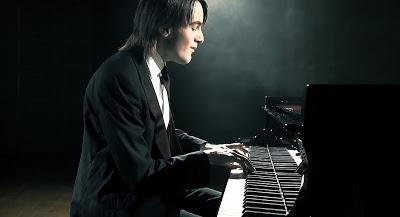by Paul J. Pelkonen

The young gun: Daniil Trifonov is set to take over the world
...and just joined the board of the New York Philharmonic.
Photo © 2015 Deutsche Grammophon/Universal Music Group.
For his grand finale, Mr. Trifonov chose to close with the Piano Concerto No. 3, the 1909 work that is equivalent to a dangerous climb up K2. Many pianists have tried....and many have professionally perished. This is a work whose reputation has eclipsed its popularity, appearin most famously in the Hollywood movie Shine. This Oscar-winning bio-pic recounts how pianist David Helfgott chose to play the work in competition and as a result wound up institutionalized and under shock therapy.
His guide on this expedition was Ludovic Morlot, the French conductor who has made a name for himself in Boston and in leading the Seattle Symphony as its music director. On Tuesday night, Mr. Trifonov and Mr. Morlot entered together, two young artists getting ready to take on this concerto. The work is so technically daunting that Josef Hoffmann, the legendary pianist who bears its dedication, refused to consider playing it before an audience.
From his first entry, Mr. Trifonov showed authority, driving the signature descending theme from his shoulders. Other, more filigreed passages had him hunched over the keyboard, mop-hair falling in his face as his long, supple fingers danced Rachmaninoff's dazzling runs and Russified rhythms, staccato figures that burst like fireworks into fountains and cascades of notes. Repeatedly, he chose passion over perfection, relying on his supple fingers and bravura technique to escape any traps hidden in the score.
For the big cadenza, Mr. Trifonov chose the longer and more difficult of Rachmaninoff's two authorized versions, skating on very thin ice as his piano opened up and in a glorious restatement of the motto theme, duplicated the mighty shout of an entire orchestra. Mr. Morlot, the third of three conductors employed by the Philharmonic for this Festival was content to let the young pianist lead the way, offering subtle accompaniment that was marred only occasionally by an excess of volume from the horns.
The slow movement is a tremendous poetic utterance, which starts simply and surges to a glorious series of climaxes, necessitating a combination of heroism, technique and control from the soloist. Mr. Trifonov played the difficult theme and variations of the finale with an appropriate proportion of dazzle and taste, choosing the latter at key moments to the overall benefit of the piece.
As the final, soft chord was uttered, the sense of completion was readily apparent. However, he offered a brief, poetic Scriabin encore, perhaps a tease of what is to come in the future from this fine artist. At just 24, he has the classical world at his feet. The only question is: what is he going to do next?
That same question seemed to puzzle the Philharmonic players as they and Mr. Morlot set about playing the evening's counterweight: the Symphonic Dances. While it is appropriate to end a lengthy celebration of Rachmaninoff with the man's final orchestral score, there was something undercooked and anticlimactic about this performance. Maybe it was that Mr. Trifonov was no longer on the stage, his place at the piano taken by Philharmonic roster pianist Eric Huebner, the instrument itself tucked away on stage right between the timpani and the harp.

